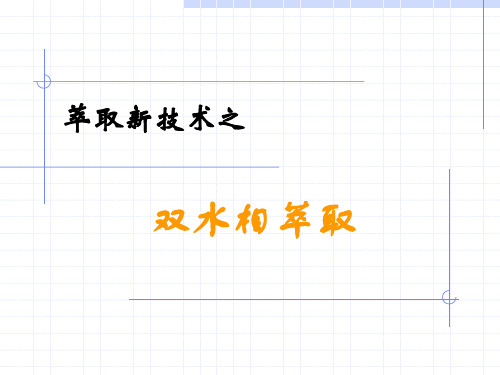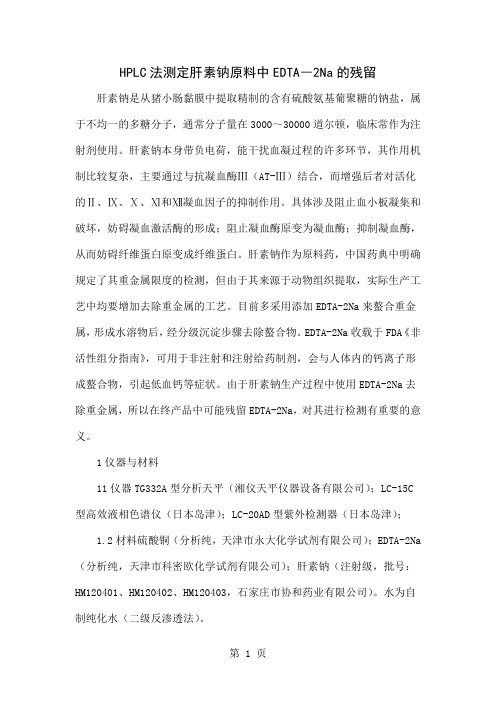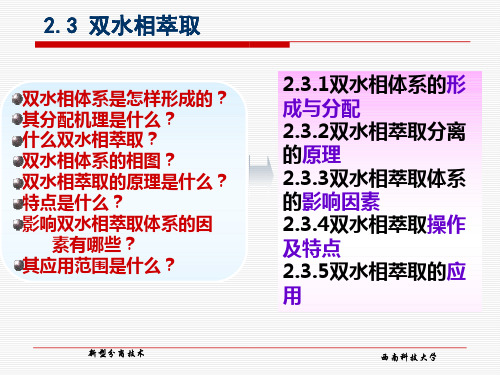硫酸葡聚糖钠盐
- 格式:doc
- 大小:39.00 KB
- 文档页数:8

肝素钠GansunaHeparin Sodium■本品系自猪或牛的肠黏膜中提取的硫酸氨基葡聚糖的钠盐,属黏多糖类物质,是由不同分子量的糖链组成的混合物,由α-D-氨基葡萄糖(N-硫酸化,O-硫酸化,或N-乙酰化)和O-硫酸化糖醛酸(α-L-艾杜糖醛酸或β-D葡萄糖醛酸)交替连接形成聚合物,具有延长血凝时间的作用。
按干燥品计算,每1mg中抗Ⅱa因子效价不得少于180 IU,抗Xa因子效价与抗IIa因子效价比为0.9~1.1。
■[修订]■核酸取本品,加水溶解并稀释制成每1ml中含4mg的溶液,照紫外-可见分光光度法(附录ⅣA)测定,在260nm的波长处,吸光度不得大于0.10。
■[增订]■蛋白质取本品适量,精密称定,加水溶解并稀释制成每1ml中约含30mg的溶液,作为供试品溶液;另取牛血清白蛋白对照品适量,分别加水制成每1ml中各含0、10μg、20μg、30μg、40μg与50μg的溶液,作为对照品溶液,照蛋白质含量测定法(附录ⅦM 第二法)测定。
按干燥品计,含蛋白质不得过0.5%。
■[增订]■有关物质取本品适量,精密称定,加水溶解并定量稀释制成每1ml中约含100mg的溶液,涡旋混合至完全溶解,取0.5ml,加入1 mol/L盐酸溶液0.25ml和25%亚硝酸钠溶液0.05ml,振摇混匀,反应40分钟,加入1mol/L氢氧化钠溶液0.2ml终止反应,作为供试品溶液;取肝素对照品250mg,加水2ml,涡旋混匀至完全溶解,作为对照品溶液(1);取对照品溶液(1)1.2ml,加2%硫酸皮肤素对照品0.15ml与2%多硫酸软骨素对照品0.15ml,作为对照品溶液(2);取对照品溶液(2)0.1ml,加水稀释至1ml,作为对照品溶液(3);取对照品溶液(1)0.4ml,加水0.1ml,混匀,加1 mol/L盐酸溶液0.25ml和25%亚硝酸钠溶液0.05ml,振摇混匀,反应40分钟,加1mol/L氢氧化钠溶液0.2ml终止反应,作为对照品溶液(4);取对照品溶液(2)0.5ml,加1 mol/L盐酸溶液0.25ml和25%亚硝酸钠溶液0.05ml,振摇混匀,反应40分钟,加1mol/L氢氧化钠溶液0.2ml终止反应,作为对照品溶液(5)。




HPLC法测定肝素钠原料中EDTA―2Na的残留肝素钠是从猪小肠黏膜中提取精制的含有硫酸氨基葡聚糖的钠盐,属于不均一的多糖分子,通常分子量在3000~30000道尔顿,临床常作为注射剂使用。
肝素钠本身带负电荷,能干扰血凝过程的许多环节,其作用机制比较复杂,主要通过与抗凝血酶Ⅲ(AT-Ⅲ)结合,而增强后者对活化的Ⅱ、Ⅸ、Ⅹ、Ⅺ和Ⅻ凝血因子的抑制作用。
具体涉及阻止血小板凝集和破坏,妨碍凝血激活酶的形成;阻止凝血酶原变为凝血酶;抑制凝血酶,从而妨碍纤维蛋白原变成纤维蛋白。
肝素钠作为原料药,中国药典中明确规定了其重金属限度的检测,但由于其来源于动物组织提取,实际生产工艺中均要增加去除重金属的工艺。
目前多采用添加EDTA-2Na来螯合重金属,形成水溶物后,经分级沉淀步骤去除螯合物。
EDTA-2Na收载于FDA《非活性组分指南》,可用于非注射和注射给药制剂,会与人体内的钙离子形成螯合物,引起低血钙等症状。
由于肝素钠生产过程中使用EDTA-2Na去除重金属,所以在终产品中可能残留EDTA-2Na,对其进行检测有重要的意义。
1仪器与材料11仪器TG332A型分析天平(湘仪天平仪器设备有限公司);LC-15C 型高效液相色谱仪(日本岛津);LC-20AD型紫外检测器(日本岛津);1.2材料硫酸铜(分析纯,天津市永大化学试剂有限公司);EDTA-2Na (分析纯,天津市科密欧化学试剂有限公司);肝素钠(注射级,批号:HM120401、HM120402、HM120403,石家庄市协和药业有限公司)。
水为自制纯化水(二级反渗透法)。
2方法与结果2.1色谱条件色谱柱:十八烷基硅烷键合硅胶填料WondaSilC18(200mm×46mm×5μm);流动相:0025mol/l硫酸铜溶液(用稀硫酸调节pH至30);检测波长:254nm;流速:10ml/min;检测温度:室温;进样量:20μl。
2.2溶液的制备2.2.1空白溶液的制备精密量取004mol/l硫酸铜溶液10ml,置50ml 量瓶中,加水稀释至刻度,摇匀,即得。

氨基葡萄糖硫酸钠盐U S P32标准Glucosamine Sulfate Sodium Chloride(C6H14NO5)2SO4·2NaCl 573.31Bis(d-Glucose, 2-amino-2-deoxy-), sulfate sodium chloride complex.Bis(2-Amino-2-deoxy- -d-glucopyranose) sulfate sodium chloride complex (-,-) [38899-05-7].» Glucosamine Sulfate Sodium Chloride contains not less than 98.0 percent a nd not morethan 102.0 percent of (C6H14NO5)2SO4·2NaCl calculated on the dried basis. Packaging and storage— Preserve in tight, light-resistant containers.USP Reference standards 11—USP Glucosamine Hydrochloride RS .Identification—A: Infrared Absorption 197K.Test solution— Transfer about 50 mg of Glucosamine Sulfate Sodium Chlorid e to a centrifuge tube,and dissolve in 2 mL of water. Add about 0.5 mL of barium chloride TS, and c entrifuge.Evaporate the supernatant, and dry the residue at 105 for 2 hours. The IR spe ctrum correspondsto that of a similar preparation of USP Glucosamine Hydrochloride RS, except that the additionof barium chloride TS is omitted.B: It meets the requirements of the tests for Chloride 191 and Sodium 191. C: The retention time of the major peak in the chromatogram of the Assay pre paration correspondsto that in the chromatogram of the Standard preparation, as obtained in the As say.D: In the test for the Content of sulfate, after the addition of barium chloride T S, a whiteprecipitate is formed.Specific rotation 781S: between +50.0 and +55.0.Test solution: 35 mg per mL. Measure the specific rotation 3 hours after sampl e preparation.pH 791 : between 3.0 and 5.0, in a solution containing 20 mg per mL.Loss on drying 731 — Dry it at 105 for 2 hours: it loses not more than 1.0% of its weight.Residue on ignition 281 : between 22.5% and 26.0%.Potassium— Acidify 5 mL of a solution (1 in 20) with 6 N acetic acid, and add 5 drops ofsodium cobaltinitrite TS: no precipitate is formed.Arsenic, Method II 211 : 3 µg per g.Heavy metals, Method II 231 : 0.001%.Content of sulfate— Transfer about 1 g of Glucosamine Sulfate Sodium Chlori de, accurately weighed, to a 250-mL beaker, and dissolve in about 100 mL of water. Add 4 mL of 6 N hydrochloric acid. Heat the solutionto boiling, and add, with constant stirring, sufficient boiling barium chloride T S to completely precipitate the sulfate.Add an additional 2 mL of barium chloride TS, and digest on a steam bath for 1 hour. Pass the mixturethrough ashless filter paper, transferring the residue quantitatively to the filter, and wash the residue withhot water until no precipitate is obtained when 1 mL of silver nitrate TS is add ed to 5 mL of washing.Transfer the paper containing the residue to a tared crucible. Char the paper, without burning, and ignitethe crucible and its contents to constant weight. Calculate the content of sulfat e by multiplying the weightobtained by 0.4116. The content of sulfate is between 16.3% and 17.3%. Assay—Phosphate buffer, Mobile phase, Standard preparation, and Chromatographic system— Proceed asdirected in the Assay under Glucosamine Hydrochloride.Assay preparation— Transfer about 100 mg of Glucosamine Sulfate Sodium Chloride, accurately weighed, to a 100-mL volumetric flask. Dissolve in 30 mL of water, shake by mechanical means, dilute with water to volume,and mix.Procedure— Proceed as directed in the Assay under Glucosamine Hydrochlor ide. Calculate thepercentage of (C6H14NO5)2SO4·2NaCl in the portion of Glucosamine Sulfate Sodium Chloride takenby the formula:10,000(573.31/431.26)(C / W)(rU / rS)in which 573.31 is the molecular weight of the glucosamine sulfate sodium chl oride and 431.26 istwice the molecular weight of glucosamine HCl; W is the weight, in mg, of Glu cosamine SulfateSodium Chloride used to prepare the Assay preparation; and the others terms are as defined therein.Auxiliary Information— Please check for your question in the FAQs before conUSP32–NF27 Page 1031Pharmacopeial Forum: Volume No. 33(4) Page 692Chromatographic Column—GLUCOSAMINE SULFATE SODIUM CHLORIDEChromatographic columns text is not derived from, and not part of, USP 32 or NF 27项目标准(美国药典版)性状白色结晶性粉末比旋度+52°—+54°pH值 3.00—4.50铁离子≤10PPM重金属≤10PPM干燥失重≤1.00%含量98.0%-102.0%(以干基计)灼烧残渣23.5—25.0%氯化物≤14.00%硫酸盐16.3%-17.3%有机挥发杂质符合要求微生物检验细菌总数酵母、霉菌沙门氏菌大肠杆菌不大于500/g 不大于100/g 不得检出不得检出包装和储存保存在密封闭光的容器内有效期两年。
肝素钠GansunaHeparin Sodium■本品系自猪或牛的肠黏膜中提取的硫酸氨基葡聚糖的钠盐,属黏多糖类物质,是由不同分子量的糖链组成的混合物,由α-D-氨基葡萄糖(N-硫酸化,O-硫酸化,或N-乙酰化)和O-硫酸化糖醛酸(α-L-艾杜糖醛酸或β-D葡萄糖醛酸)交替连接形成聚合物,具有延长血凝时间的作用。
按干燥品计算,每1mg中抗Ⅱa因子效价不得少于180 IU,抗Xa因子效价与抗IIa因子效价比为0.9~1.1。
■[修订]■核酸取本品,加水溶解并稀释制成每1ml中含4mg的溶液,照紫外-可见分光光度法(附录ⅣA)测定,在260nm的波长处,吸光度不得大于0.10。
■[增订]■蛋白质取本品适量,精密称定,加水溶解并稀释制成每1ml中约含30mg的溶液,作为供试品溶液;另取牛血清白蛋白对照品适量,分别加水制成每1ml中各含0、10μg、20μg、30μg、40μg与50μg的溶液,作为对照品溶液,照蛋白质含量测定法(附录ⅦM 第二法)测定。
按干燥品计,含蛋白质不得过0.5%。
■[增订]■有关物质取本品适量,精密称定,加水溶解并定量稀释制成每1ml中约含100mg的溶液,涡旋混合至完全溶解,取0.5ml,加入1 mol/L盐酸溶液0.25ml和25%亚硝酸钠溶液0.05ml,振摇混匀,反应40分钟,加入1mol/L氢氧化钠溶液0.2ml终止反应,作为供试品溶液;取肝素对照品250mg,加水2ml,涡旋混匀至完全溶解,作为对照品溶液(1);取对照品溶液(1)1.2ml,加2%硫酸皮肤素对照品0.15ml与2%多硫酸软骨素对照品0.15ml,作为对照品溶液(2);取对照品溶液(2)0.1ml,加水稀释至1ml,作为对照品溶液(3);取对照品溶液(1)0.4ml,加水0.1ml,混匀,加1 mol/L盐酸溶液0.25ml和25%亚硝酸钠溶液0.05ml,振摇混匀,反应40分钟,加1mol/L氢氧化钠溶液0.2ml终止反应,作为对照品溶液(4);取对照品溶液(2)0.5ml,加1 mol/L盐酸溶液0.25ml和25%亚硝酸钠溶液0.05ml,振摇混匀,反应40分钟,加1mol/L氢氧化钠溶液0.2ml终止反应,作为对照品溶液(5)。
目录编号:101516,101518,150821,160110,160111,193992结构:CAS#:9011-18-1物性描述:白色至灰白色粉末说明:硫酸葡聚糖是一种阴离子所产生的氯磺酸酯化葡聚糖葡聚糖衍生物。
中的硫含量是约17%,这对应于1.9硫酸基团的每个葡萄糖残基的葡聚糖分子的平均。
典型用途:•提高核酸杂交率 - 10%葡聚糖硫酸酯的存在下在溶液中的DNA,再退火率增加了约10:times.15此观察,后来扩大到DNA或单链或双链探针杂交核糖核酸固定关于滤波器paper.9,16 10%硫酸葡聚糖,除了可能会增加随机切割的双链DNA探针固定化核酸的杂交率高达100 times.16显示免疫相关活动:1。
增强和抑制的体液immunity3,4的2。
多克隆激活B淋巴细胞,刺激甚至是未成熟的B cells63。
在胸腺细胞反应lectins1的变化4。
抑制血液凝固和血小板aggregation115。
加强血纤溶activity11的6。
增强/抑制细胞介导的免疫responses.2 10的析出物的LDL和VLDL脂蛋白 - 硫酸葡聚糖沉淀镁离子的存在下,从人血清中的低密度脂蛋白留在上清液中高密度脂蛋白。
可能是有用的其他材料,如β2-glycoprotein.8的纯化硫酸葡聚糖沉淀去除脂蛋白•显示活动作为佐剂可用性:目录编号说明大小101516葡聚糖硫酸酯钠盐,试剂级,平均相对分子质量:80001克10克50克100克101518葡聚糖硫酸酯钠,临床级;平均分子量:6000 - 80001克10克50克100克150821葡聚糖硫酸酯钠盐;平均分子量:1,400,000葡聚糖分子量:5000001克10克50克100克500克160110葡聚糖硫酸酯钠盐;平均分子量:36000 - 500001克10克50克100克500克160111葡聚糖硫酸酯钠盐;平均分子量:400000 - 6000001克10克50克100克193992葡聚糖硫酸酯钠,分子生物学试剂,平均分子量:1,400,0001克10克50克100克500克溶解性:易溶于水(100毫克/毫升 - 明确略带浑浊的黄色溶液。
目录编号:101516,101518,150821,160110,160111,193992结构:CAS#:9011-18-1物性描述:白色至灰白色粉末说明:硫酸葡聚糖是一种阴离子所产生的氯磺酸酯化葡聚糖葡聚糖衍生物。
中的硫含量是约17%,这对应于1.9硫酸基团的每个葡萄糖残基的葡聚糖分子的平均。
典型用途:•提高核酸杂交率 - 10%葡聚糖硫酸酯的存在下在溶液中的DNA,再退火率增加了约10:times.15此观察,后来扩大到DNA或单链或双链探针杂交核糖核酸固定关于滤波器paper.9,16 10%硫酸葡聚糖,除了可能会增加随机切割的双链DNA探针固定化核酸的杂交率高达100 times.16显示免疫相关活动:1。
增强和抑制的体液immunity3,4的2。
多克隆激活B淋巴细胞,刺激甚至是未成熟的B cells63。
在胸腺细胞反应lectins1的变化4。
抑制血液凝固和血小板aggregation115。
加强血纤溶activity11的6。
增强/抑制细胞介导的免疫responses.2 10的析出物的LDL和VLDL脂蛋白 - 硫酸葡聚糖沉淀镁离子的存在下,从人血清中的低密度脂蛋白留在上清液中高密度脂蛋白。
可能是有用的其他材料,如β2-glycoprotein.8的纯化硫酸葡聚糖沉淀去除脂蛋白•显示活动作为佐剂可用性:目录编号说明大小101516葡聚糖硫酸酯钠盐,试剂级,平均相对分子质量:80001克10克50克100克101518葡聚糖硫酸酯钠,临床级;平均分子量:6000 - 80001克10克50克100克150821葡聚糖硫酸酯钠盐;平均分子量:1,400,000葡聚糖分子量:5000001克10克50克100克500克160110葡聚糖硫酸酯钠盐;平均分子量:36000 - 500001克10克50克100克500克160111葡聚糖硫酸酯钠盐;平均分子量:400000 - 6000001克10克50克100克193992葡聚糖硫酸酯钠,分子生物学试剂,平均分子量:1,400,0001克10克50克100克500克溶解性:易溶于水(100毫克/毫升 - 明确略带浑浊的黄色溶液。
较高分子量的产品可能不溶于水的低分子量产品。
)。
水溶液应在高压灭菌前,以防止decomposition.17缓冲(例如碳酸氢钠)参考文献:1。
E.,blitstein维林格尔舒茨,G.和Diamanststein,T.,“在胸腺细胞的反应性的变化,不同的硫酸化的聚阴离子的B细胞有丝分裂原的外源凝集素。
免疫学,诉30,529-533(1976)。
2。
布拉德菲尔德,枣疯病,Souhami,RL,艾迪,乙脑,“硫酸葡聚糖的辅助行动的机制。
”免疫学,诉26,383-386(1974)。
3。
diamantstein,T.,等人,“刺激体液抗体形成由聚阴离子II。
硫酸酯的聚合物对免疫反应对小鼠的影响。
欧洲免疫学杂志,诉1,340-343(1971)。
4。
diamantstein,T.,等人,“抑制体内羊红血细胞B细胞有丝分裂原的初级免疫反应的。
”免疫学,诉30,401-405(1976)。
5。
芬利,PR,等人,“高密度脂蛋白胆固醇的:使用的Mg 2 /硫酸葡聚糖在其氧化酶法测定。
临床化学,诉24,931-933(1978)。
6。
granstrom,M.,等人,“多克隆B细胞活化剂,硫酸葡聚糖诱导形成细胞集落刺激活性。
” SCAND。
免疫学杂志,诉7,277-284(1978)。
7。
laderman,L.,川崎市,ES和Szabo的,P.,“细胞学制备的核酸退火的速率增加的硫酸葡聚糖的存在。
”肛门。
生化,诉117,158-163(1981)。
8。
兰宾,P.和伯斯坦,M.,“从人血清中分离的β2-糖蛋白沉淀后,用硫酸葡聚糖和氯化锰。
Biochimie,诉64,1065-1071(1982)。
9。
曼尼阿蒂斯T.,弗里奇,大肠杆菌和萨姆布鲁克,F.(合编),分子克隆:实验室手册,冷泉港实验室(1982年)。
10。
McCarthey,R.E.巴布科克,GF,同时刺激和抑制两个不同的指标的细胞介导的免疫反应的免疫调节剂的硫酸葡聚糖。
免疫学,诉34,827-929(1978)。
11。
岛,K.,等,“硫酸葡聚糖对自发性高血压大鼠凝血和纤溶。
”进阶Inflamm。
住宅,诉1,331-337(1979)。
12。
里基茨,CR,“硫酸葡聚糖 - 肝素合成类似物。
”生物化学,诉51,129-133(1952)。
13。
里基茨,CR,“一个基本的衍生物,葡聚糖和其与血清白蛋白。
”生物化学。
J.,诉76,117-120(1960)。
14。
warnick,GR,等人,“高密度脂蛋白胆固醇定量用磷钨酸 - 镁离子,硫酸葡聚糖 - 锰 - 聚乙二醇沉淀,用酶法胆固醇测定与脂质研究方法相比。
”阿米尔。
J.临床。
病理学,诉78,718-723(1982)。
15。
Wetmur,JG,“加速DNA的复性率。
”生物聚合物,14节,2517年至2524年(1975年)。
16。
瓦尔,通用,等人,“高效的大的DNA片段从琼脂糖凝胶中转移到diazobenzyloxymethyl纸和快速杂交与葡聚糖硫酸酯。
PROC。
国家ACAD。
SCI 收录。
美国,诉76,3683(1979)。
17。
默克指数,12版,第2993号。
Catalog Number: 101516, 101518, 150821, 160110, 160111, 193992 Dextran sulfate sodium saltStructure:CAS # : 9011-18-1Physical Description: White to off-white powderDescription: Dextran sulfate is a polyanionic derivative of dextran produced by esterification of Dextran with chlorosulphonic acid. The sulfur content is approximately 17% which corresponds to an average of 1.9 sulfate groups per glucosyl residue of the dextran molecule.Typical Uses:•Increases hybridization rate of nucleic acids - in the presence of 10% dextran sulfate the rate of reannealing ofDNA in solution was increased by about 10 times.15 Thisobservation was later extended to the hybridization of singleor double-stranded probes to DNA or RNA immobilized on filterpaper.9,16The addition of 10% dextran sulfate may increase therate of hybridization of randomly cleaved double-strandedDNA probes to immobilized nucleic acids by as much as 100times.16•Shows immunologically relevant activities:1.enhancement and suppression of humoralimmunity3,42.polyclonal activation of B-lymphocytes,stimulating even immature B cells63.changes in thymocyte reactivity to lectins14.inhibition of blood coagulation and plateletaggregation115.enhancement of blood fibrinolytic activity116.enhancement/suppression of cell-mediatedimmune responses.2,10•Precipitates LDL and VLDL lipoproteins - in the presence of magnesium ions, dextran sulfate precipitates low-densitylipoproteins from human serum leaving the high-densitylipoproteins in the supernatant. Removal of lipoproteins bydextran sulfate precipitation may be useful in thepurification of other materials such as beta2-glycoprotein.8•Shows activity as an adjuvantAvailability:solution. Higher molecular weight products may not be as soluble in water as the lower molecular weight products.). Aqueous solutions should be buffered with (e.g. with sodium bicarbonate) before autoclaving to prevent decomposition.17References:1.Blitstein-Willinger, E., Schutz, G. and Diamanststein, T.,"Changes in thymocyte reactivity to lectins by B-cell mitogens of the type of sulphated polyanions." Immunology, v. 30, 529-533(1976).2.Bradfield, J.W.B., Souhami, R.L., Addison, J.E., "The mechanism ofthe adjuvant action of dextran sulphate." Immunology, v. 26,383-386 (1974).3.Diamantstein, T., et al., "Stimulation of humoral antibodyformation by polyanions. II. The influence of sulphate esters of polymers on the immune response on mice." Eur. J. Immunol., v. 1, 340-343 (1971).4.Diamantstein, T., et al., "Suppression of the primary immuneresponse in vivo to sheep red blood cells by B-cell mitogens."Immunology, v. 30, 401-405 (1976).5.Finley, P.R., et al., "Cholesterol in high-density lipoprotein: Useof Mg+2/dextran sulphate in its enzymatic measurement." Clin. Chem., v. 24, 931-933 (1978).6.Granstrom, M., et al., "The polyclonal B-cell activator Dextransulphate induces formation of colony stimulating activity." Scand.J. Immunol., v. 7, 277-284 (1978).derman, L., Kawasaki, E.S and Szabo, P., "The rate of nucleic acidannealing to cytological preparation is increased in the presence of dextran sulphate." Anal. Biochem., v. 117, 158-163 (1981).mbin, P. and Burstein, M., "Isolation of a beta2-glycoproteinfrom human serum after precipitation with dextran sulphate andmanganese chloride." Biochimie, v. 64, 1065-1071 (1982).9.Maniatis, T., Fritsch, E. and Sambrook, F. (eds.), MolecularCloning: A Laboratory Manual, Cold Spring Harbor Laboratory (1982).10.McCarthey, R.E. and Babcock, G.F., "Simultaneous stimulation andsuppression of two different indicators of the cell-mediated immune response by the immunoregulator dextran sulphate." Immunology, v.34, 827-929 (1978).11.Nakajima, K., et al., "Effects of dextran sulphate on bloodcoagulation and fibrinolysis in spontaneously hypertensive rats."Adv. Inflamm. Res., v. 1, 331-337 (1979).12.Ricketts, C.R., "Dextran Sulphate - A synthetic analogue ofHeparin." Biochemistry, v. 51, 129-133 (1952).13.Ricketts, C.R., "A basic derivative of dextran and its interactionwith serum albumin." Biochem. J., v. 76, 117-120 (1960).14.Warnick, G.R., et al., "HDL cholesterol quantitation byphosphotungstate - Mg2+and by dextran sulphate - Mn2+- polyethylene glycol precipitation, both with enzymatic cholesterol assaycompared with the lipid research method." Amer. J. Clin. Pathol., v. 78, 718-723 (1982).15.Wetmur, J.G., "Acceleration of DNA renaturation rates."Biopolymers, v. 14, 2517-2524 (1975).16.Wahl, G.M., et al., "Efficient transfer of large DNA fragments fromagarose gels to diazobenzyloxymethyl-paper and rapid hybridization with dextran sulfate." Proc. Natl. Acad. Sci. USA, v. 76, 3683 (1979).17.Merck Index, 12th Ed., No. 2993.。